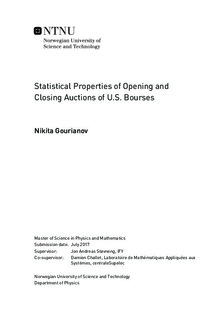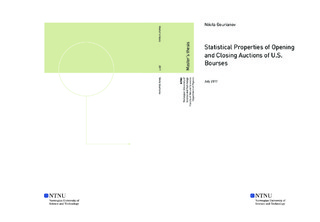| dc.description.abstract | Major stock exchanges typically open and close by employing so-called single-price auctions. The auctions work by gathering orders through a pre-auction period, finding the price that match the greatest quantity of buy and sell orders, and finally execute the orders at the final auction price just before continuous trading begins.
The opening and closing auctions of major U.S. stock exchanges account for up to 10% of total daily trading dollar-volume, yet they have received little attention from the academic community. To amend this, we characterised the statistical properties of the auctions of NYSE, NYSEarca and NASDAQ by approaching them as physical systems.
Using various statistical fitting and testing methods, it was established that the distribution in sizes of individual trades matched at the NYSEarca opening \& closing auctions are heavy-tailed, and that the ratio of daily dollar-volume between opening and closing auctions is log-normally distributed for the stocks of NYSE, NYSEarca and NASDAQ.
Next, time-regressive methods were used to show that the auctions' daily dollar-volume is predictable to a significant extent for the stocks of NYSEarca and NASDAQ.
Afterwards, two regularities in the pre-auction period, which is when the auction participants send in their orders, of NYSEarca opening auctions were found: Firstly, the dollar-volume of the buy \& sell orders matched with each other exhibits linear growth as a function of time for the stocks of NYSEarca. Secondly, the indicative price of the auction, which functions as an estimate for the final price of the auction, is shown to systematically over-estimate the final price by $0.05$-$0.1$\% between the $65$th and $85$th minutes of the pre-auction period for the stocks of NYSEarca.
Finally, the price dynamics of the pre-auction period of NYSEarca opening auctions were investigated by using linear response functions to study the effect new orders, and order cancellation, have on the auction price. Here it was found that orders which contribute to the current imbalance (between buy and sell orders) cause a much larger price response than orders which counteract the imbalance, that the price response of all order types tend to zero as the pre-auction period nears its end, and other stylised facts.
This work has successfully produced an overview of the quantitative properties of the opening and closing auctions of U.S. stock exchanges, and also outlined the way for more in-depth investigations into the opening and closing auctions. | |

